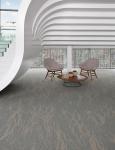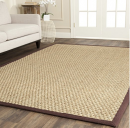Flooring: Carpets & Adhesives
In 2018, San Francisco adopted a comprehensive carpet regulation that is among the strictest in the nation. It applies to purchases made by or on behalf of City departments. It has minimum recycled content requirements and prohibitions on a long list of hazardous chemicals, including persistent, highly fluorinated compounds.
For lists of compliant products available in the USA and ordering instructions, click "Manufacturers" links below.
For purchasing criteria, template specifications, and other details, click:
Info on this product category: Flooring: Carpets & Adhesives
Why Go Green
San Francisco's regulation includes a ban on these toxic chemicals in carpet tiles and broadloom (rolled) carpet (excluding area rugs):
-
Antimicrobial chemicals because they can make bacteria resistant to antibiotics and disrupt our hormones. It is not necessary for city department carpet to have antimicrobial chemicals.
-
Flame retardant chemicals because they do little, if anything, to slow or prevent fire. They migrate out of products and escape into our air, dust and our bodies. And they’re associated with cancer, lower intelligence quotient (IQ), and reproductive harm.
-
Per- and poly-fluoroalkyl substances (PFAS) because they are associated with cancer, high cholesterol and obesity. They have been found to migrate out of products and get into our air, dust, water and bodies. San Francisco's regulation requires carpets to have cationic nylon yarn. It is soil stain resistant and does not require toxic fluorinated chemicals.
-
Polyvinyl chloride (PVC) because it usually has phthalates (some of which disrupt our hormones and probably causes cancer), and sometimes it has lead (which can cause reproductive problems and nerve disorders), and when PVC is made or disposed, it releases cancer-causing dioxins.
The regulation requires certification as Cradle-to-Cradle (TM) Silver, which includes a longer list of prohibited chemicals, limits on volatile organic compounds (VOCs), and also carries requirements for materials reutilization, renewable energy and carbon management, water stewardship and social fairness.
Finally, the regulation requires a minimum recycled content of 45%, of which 10% must be postconsumer content.
Tips
Get an update when we publish non-carpet flooring alternatives. For example, carpets are not suitable in hospital settings because it can be hard to get germs out of carpet.
Carpet and carpet padding must be recycled as follows. They must be separated from other waste:
- Kept dry
- Kept debris free (i.e. free of trash, dirt, tack strips, cutting blades, nails, sharps, etc)
- Rolled, stacked or folded
- Broadloom carpet must be:
- Cut into manageable sections
- Separated from any carpet padding if applicable
100% of existing carpet including carpet padding must be taken to a recycling facility that accepts these products for recycling unless otherwise required by law. Recycling means turning any manufacturer’s old carpet or carpet components into new carpet or other consumer products. Recycling does not include:
- Carpet As Alternative Fuel (CAAF)
- Burning carpet in cement kilns
- Waste-to-energy (WTE)
- Any high temperature material destruction or conversion
- Carpet used as alternative daily cover (ADC)
Get written verification from the manufacturer or contractor with the project close-out documentation that existing carpet that was removed from the facility was taken to a carpet recycling facility.
Criteria for Flooring: Carpets & Adhesives
Criteria for Required products:
Compliant carpets: Must meet criteria in the carpet regulation at bit.ly/sfcarpetreg.
Exceptions: The purchase of noncompliant products, including broadloom carpet and noncompliant hardbacked carpet tiles, is permitted only under the following circumstances.
(a) Area rugs;
(b) Patch replacements for existing carpet;
(c) Renovations that require replacement carpet of a specific thickness, where replacement carpet that both is the required thickness and meets the requirements of Item D, cannot reasonably be obtained;
(d) Carpet for historic spaces, where the San Francisco Historic Preservation Commission or some other public policy body must approve the carpet, and carpet that complies with the requirements herein would necessarily fail to meet the standards of such a body.
All carpets, regardless of exceptions, must at a minimum meet the VOC requirements in the carpet regulation.
For construction project manuals: Use this carpet tile template specification (from June 8, 2018): bit.ly/sfcarpettilespec. It includes the carpet regulation requirements as a basis for Section 09 68 13.






